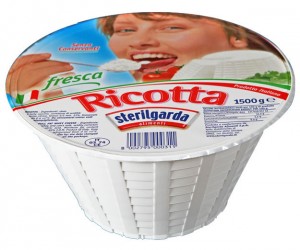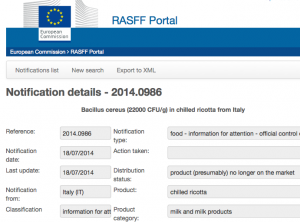Withdrawn from the shelves cottage cheese SterilgardaRitirata dagli scaffali ricotta Sterilgarda

Withdrawn from the shelves cottage cheese Sterilgarda: European alert is triggered, but the product is not there, it is already expired. Reflections on a system is not always so efficient
The news is one that leaves no one indifferent: Sterilgarda withdraws from the market and recall packs of fresh ricotta for the presence of Bacillus cereus. The communication is re-launched by the Ministry of Health on July 18 European alert system (RASFF) because it is a product sold in Italy, France and Singapore. From the card it turns out that the batch consists of packs of 1.5 kg mostly used in restaurants and community. Intrigued by the news Sterilgarda call confirming the withdrawal of the product in response to a notification by the ASL of Reggio Emilia stating that they have taken this decision with some reservations: the values of Bacillus cereus are not so high as to justify such a measure.
Lot accused is no longer in business because the expiration date on the packaging indicates July 17, the day before the request for withdrawal by the ASL. Yes you read right, the alert system has been activated for a virtually expired, that in 99.99% of cases has been consumed for many days. Another worrying fact is that the sample is taken from the market July 1, but the notification is dated July 18.
RASFF Sterilgarda ricotta cheese
In this curious story three thoughts arise spontaneously. Why have passed 17 days after collection of cottage cheese at the time of the alert? If instead of the Bacillus cereus (present in relatively small quantities – see note *) ricotta had had a more serious problem (high presence of Listeria monocytogenes), the alert system would be activated too late, thwarting any kind of preventive intervention for safeguard consumers? What sense does it initiate a withdrawal from the shelves and a recall for a product that no longer exists?
A withdrawal and recall operations are complex, involving dozens of people of ASL and involve a lot of expenses for the company. It is therefore an important measure to be taken with extreme urgency and without hesitation when there is a serious problem, but it is equally absurd to mobilize the structures of ASL and a company to withdraw a product expired and presumably no longer on the shelves.
* Bacillus cereus: According to the details of the RASFF the presence of Bacillus cereus in cheese Sterilgarda amounted to 22,000 cfu / g. According tabs Ceirsa which gives an indication on the extent of risk and the limitations of the law, the underlying schema evaluates the value as “not satisfactory”.
– Value satisfactory guide
– Acceptable value guide ≤ x 100
– Value guide is not satisfactory ≥ 10,000 (cfu / g)
– Terms of ≥ 100,000 potentially dangerous and / or C (+)
Ritirata dagli scaffali ricotta Sterilgarda: scatta l’allerta europea, ma il prodotto non c’è, è già scaduto. Riflessioni su un sistema non sempre così efficiente
La notizia è di quelle che non lascia indifferenti: Sterilgarda ritira e richiama dal mercato confezioni di ricotta fresca per la presenza di Bacillus cereus. La comunicazione viene rilanciata anche dal Ministero della salute il 18 luglio sul Sistema di allerta europeo (Rasff)perché si tratta di un prodotto venduto in Italia, Francia e a Singapore. Dalla scheda si scopre che il lotto è composto da confezioni di 1,5 kg utilizzate per lo più in ristoranti e collettività. Incuriositi dalla notizia chiamiamo Sterilgarda che conferma il ritiro del prodotto in seguito ad una notifica da parte dell’Asl di Reggio Emilia precisando di avere adottato questa decisione con alcune riserve: i valori di Bacillus cereus non sono così elevati da giustificare un provvedimento del genere.
Il lotto sotto accusa non è più in commercio perché la data di scadenza sulla confezione indica il 17 luglio, ovvero il giorno prima della richiesta di ritiro da parte dell’ASL. Sì avete capito bene, il sistema di allerta è stato attivato per un prodotto praticamente scaduto, che nel 99,99% dei casi è stato consumato già da molti giorni. L’altro dato inquietante è che il campione risulta prelevato dal commercio il 1 luglio, ma la notifica è datata 18 luglio.
In questa curiosa storia sorgono spontanee tre riflessioni. Perché sono passati 17 giorni dal prelievo della ricotta al momento dell’allerta? Se anziché il Bacillus cereus (presente in quantità abbastanza ridotte – vedi nota*) la ricotta avesse avuto un problema più serio (presenza elevata di Listeria monocytogenes), il sistema di allerta si sarebbe attivato ugualmente in ritardo, vanificando ogni tipo di intervento preventivo per salvaguardare i consumatori? Che senso ha avviare un ritiro dagli scaffali e un richiamo per un prodotto che non c’è più?
Un ritiro e un richiamo sono operazioni complesse che coinvolgono decine di persone delle Asl e comportano molte spese per l’azienda. È quindi un provvedimento importante da adottare con estrema urgenza e senza esitazioni quando si riscontra un problema serio, ma è altrettanto assurdo mobilitare le strutture delle Asl e di un’azienda per ritirare un prodotto scaduto e presumibilmente non più sugli scaffali.
*Bacillus cereus: Secondo le scheda del Rasff la presenza di Bacillus cereus nella ricotta Sterilgarda ammonta a 22.000 cfu/g. Secondo le schede del Ceirsa che fornisce un’indicazione sull’entità del rischio e i limiti di legge, lo schema sottostante valuta il valore come “non soddisfacente”.
– Valore guida soddisfacente
– Valore guida accettabile 100≤ x
– Valore guida non soddisfacente ≥10.000 (ufc/g)
– Condizioni di potenziale dannosità ≥100.000 e/o C(+)


